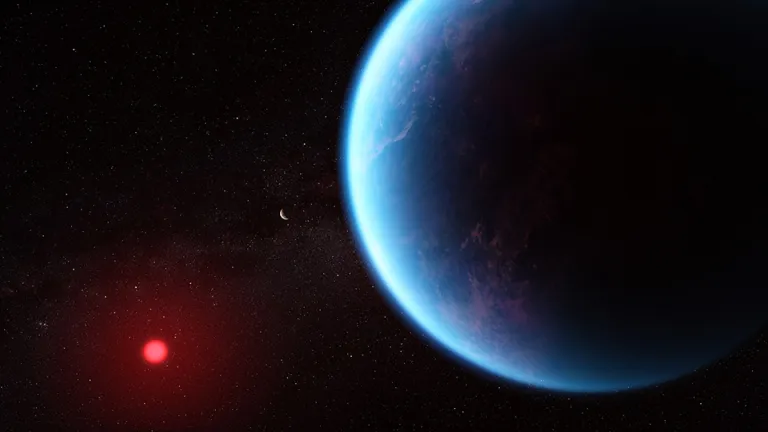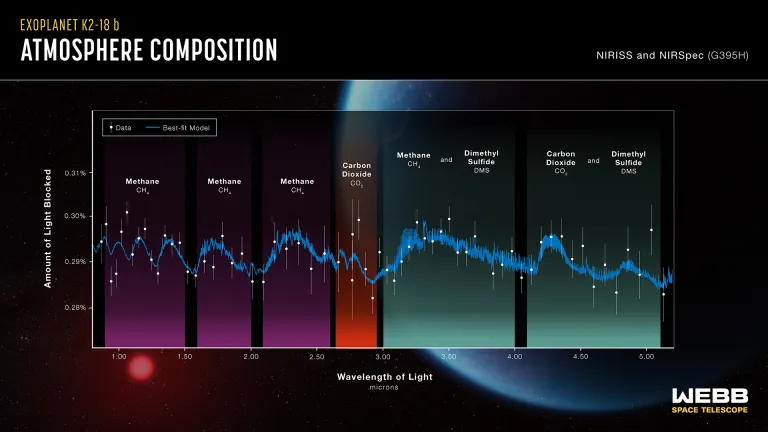Tags: life on k2-18 b, is k2-18b habitable, water in k2-18b. k2-18b distance from earth, k2-18b atmosphere, james web space telescope
A recent exploration carried out with the NASA’s James Webb Space Telescope has delved into the characteristics of K2-18 b, an exoplanet approximately 8.6 times the mass of Earth. This investigation has unveiled the presence of carbon-bearing molecules, including methane and carbon dioxide, within its atmosphere. This significant discovery by Webb contributes to the growing body of research suggesting that K2-18 b might be categorized as a Hycean exoplanet, one that potentially possesses a hydrogen-rich atmosphere and a surface predominantly covered by a water ocean.
The initial insights into the atmospheric properties of this exoplanet, which orbits in the habitable zone of the cool dwarf star K2-18 and is located 120 light-years away in the Leo constellation, were derived from observations made with NASA’s Hubble Space Telescope. These initial findings prompted further research that has since transformed our understanding of the K2-18 b system.

Illustration: NASA, CSA, ESA, J. Olmsted (STScI), Science: N. Madhusudhan (Cambridge University)
K2-18 b falls within a unique category of exoplanets, referred to as “sub-Neptunes,” characterized by sizes lying between those of Earth and Neptune. These sub-Neptunes differ significantly from any celestial bodies in our solar system, making them a subject of limited familiarity among astronomers. Consequently, understanding the composition of their atmospheres remains a topic of ongoing debate within the scientific community.
The idea that K2-18 b might qualify as a Hycean exoplanet is particularly intriguing because some scientists believe that such exoplanets could offer promising environments for the potential discovery of extraterrestrial life.
Nikku Madhusudhan, an astronomer at the University of Cambridge and the lead author of the research paper announcing these findings, emphasizes, “Our findings underscore the importance of considering diverse habitable environments in the search for life elsewhere. Traditionally, the search for life on exoplanets has focused primarily on smaller rocky planets, but the larger Hycean worlds are significantly more conducive to atmospheric observations.”
The presence of methane and carbon dioxide, along with the scarcity of ammonia, lends support to the hypothesis that there may exist a water ocean beneath a hydrogen-rich atmosphere on K2-18 b. Additionally, initial observations by Webb have suggested the possible detection of a molecule called dimethyl sulfide (DMS), which on Earth is primarily produced by living organisms, particularly phytoplankton in marine environments. The presence of DMS, though requiring further validation, remains an intriguing aspect of this discovery.
Is K2-18 b habitable?
It is essential to note that while K2-18 b resides within the habitable zone and hosts carbon-bearing molecules, this alone does not guarantee its ability to sustain life. The planet’s considerable size, with a radius 2.6 times that of Earth, implies the likelihood of a substantial mantle of high-pressure ice, resembling Neptune, coupled with a thinner hydrogen-rich atmosphere and a surface covered by an ocean. Although Hycean worlds are hypothesized to harbor water oceans, there is also the possibility that these oceans may be excessively hot or even non-liquid, rendering them inhospitable.
Subhajit Sarkar of Cardiff University, a member of the research team, highlights, “Although this kind of planet does not exist in our solar system, sub-Neptunes are the most common type of planet known so far in the galaxy. We have obtained the most detailed spectrum of a habitable-zone sub-Neptune to date, and this allowed us to work out the molecules that exist in its atmosphere.”
Characterizing the atmospheres of exoplanets like K2-18 b, including the identification of their gases and physical conditions, represents a dynamic field of study within astronomy. However, these exoplanets often face the challenge of being outshone by their significantly brighter parent stars, complicating the task of exploring their atmospheres.
To circumvent this challenge, the research team adopted an innovative approach by analyzing the light from K2-18 b’s host star as it passed through the exoplanet’s atmosphere. K2-18 b is a “transiting” exoplanet, which means that when it moves across its host star’s face, there is a detectable decrease in the star’s brightness. This is how the exoplanet was originally discovered in 2015 through NASA’s K2 mission. During these transits, a small fraction of starlight traverses the exoplanet’s atmosphere before reaching telescopes like Webb. The passage of starlight through the exoplanet’s atmosphere leaves distinctive traces that astronomers can utilize to ascertain the composition of the exoplanet’s atmosphere.
Nikku Madhusudhan emphasizes the significance of Webb’s capabilities, stating, “This result was only possible because of the extended wavelength range and unprecedented sensitivity of Webb, which enabled robust detection of spectral features with just two transits. For comparison, one transit observation with Webb provided comparable precision to eight observations with Hubble conducted over a few years and in a relatively narrow wavelength range.”

Image Credit: NASA, CSA, ESA, R. Crawford (STScI), J. Olmsted (STScI), Scientific Research: N. Madhusudhan (Cambridge University)
Savvas Constantinou, a member of the research team from the University of Cambridge, notes, “These results are the product of just two observations of K2-18 b, with many more on the way. This means our work here is but an early demonstration of what Webb can observe in habitable-zone exoplanets.”
The team’s research findings have been accepted for publication in The Astrophysical Journal Letters. Their future plans include further research using Webb’s MIRI (Mid-Infrared Instrument) spectrograph, with the hope of validating and expanding upon their discoveries regarding the environmental conditions on K2-18 b.
Ultimately, Madhusudhan concludes with an ambitious vision, stating, “Our ultimate goal is the identification of life on a habitable exoplanet, which would transform our understanding of our place in the universe. Our findings are a promising step towards a deeper understanding of Hycean worlds in this quest.”
The James Webb Space Telescope stands as the foremost space science observatory globally, unraveling mysteries within our solar system, exploring distant exoplanets orbiting other stars, and probing the enigmatic structures and origins of our universe, thereby reshaping our perception of our position in the cosmos. This international endeavor is led by NASA in collaboration with the ESA (European Space Agency) and the Canadian Space Agency.